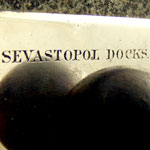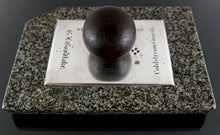A Coldstream Guards Victoria Cross Recipient’s Crimean Trophy Paperweight, 1854
Adding product to your cart
Measurements: Length: 12cm
Formed of granite, with a purposely champfered corner, taken from Russian fortifications in the Crimea, applied with a silver plaque inscribed ‘G.L. Goodlake / Sevastopol Docks / Coldstream Guards’, and mounted with a large calibre musket ball.
As a twenty-two year old Brevet-Major in the Coldstream Guards during the Crimean War, Gerald Littlehales Goodlake distinguished himself as the commander of a sharpshooter unit over forty-two days in 1854, raiding outposts and picking off sentries. Originally comprising three Guards officers and sixty-nine marksmen, the unit was equipped with the new rifle developed by French Army officer Claude-Étienne Minié, which although tricky to reload, had a rifled barrel, improved ammunition and was accurate up to a distance of 1,000 yards.
Read more
With one of the sharpshooter officers becoming a casualty and the other caught up in a disciplinary enquiry, Goodlake was in command three days after the Battle of Balaclava, when on 28th October 1854, the Russians advanced in front of the 2nd Division picquet. Operating independently in a ravine below the Inkerman Heights, Goodlake spotted some caves ahead and decided to investigate. Leaving the rest of the patrol to keep watch, he was carrying out his search with Sergeant Ashton when a Russian column approached them and the sharpshooter group. Sergeant Ashton reportedly reminded Goodlake that capture probably meant death in retaliation for the successful attack they had carried out some days earlier on a Russian outpost (where Private Stanlack won another V.C. for the Coldstream Guards). Moments later they engaged the closest Russians, killing two and attacking others with the butt-ends of their rifles as they pushed their way through and found cover in the broken ground. Meanwhile fire was being exchanged between the Russians and the sharpshooter group who assumed that their officer and sergeant had been captured or killed and were withdrawing to a ditch from where they could hold off the superior force. Goodlake’s shouts however alerted them to his and Ashton’s presence before he and the sergeant made a dash to rejoin them. Together they held off the Russians until relieved by 2nd Bn Rifle Brigade.
Lieutenant-General Gerald Littlehales Goodlake (1832-1890) was educated at Eton and commissioned into the 21st Foot on 14 June 1850. He exchanged into the Coldstream Guards by purchase in 1851, and served in the Crimea during 1854-55 with the 1st Battalion, being present at the Battles of Alma, Inkerman and Balaclava and the Siege and Fall of Sevastopol. A fine portrait of Goodlake by James Edgell Collins is in the Newstead Abbey collection. His Victoria Cross is displayed at The Guards Regimental Headquarters (Coldstream Guards RHQ) in Wellington Barracks. The full exploits of Goodlake can be found in Michael Springman’s Sharpshooter in the Crimea (2005).
In a letter dated 19 December 1855, Goodlake referred to the probable origin of the present paperweight: "They are working hard on the docks, preparing them for their destruction. I brought away several sticks and pieces of granite to make paperknives [sic]....They shelled us a good deal from the north side; about nine shells fell into the docks while I was there, killed two men and wounded three of the 18th. They have killed very few considering, since the town was taken."






